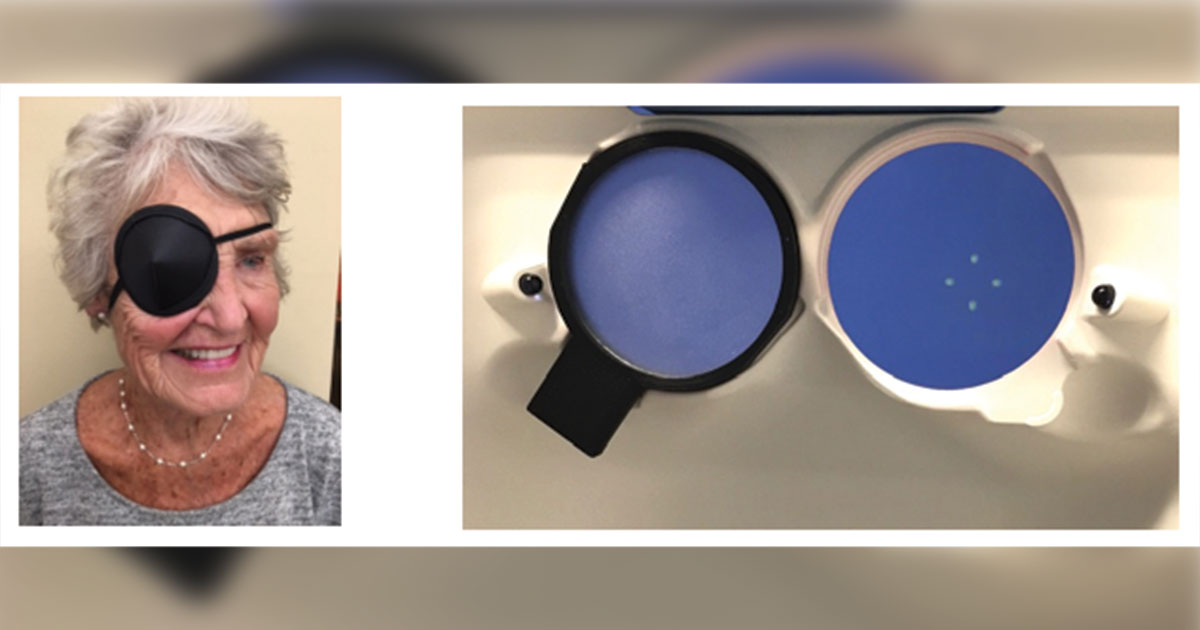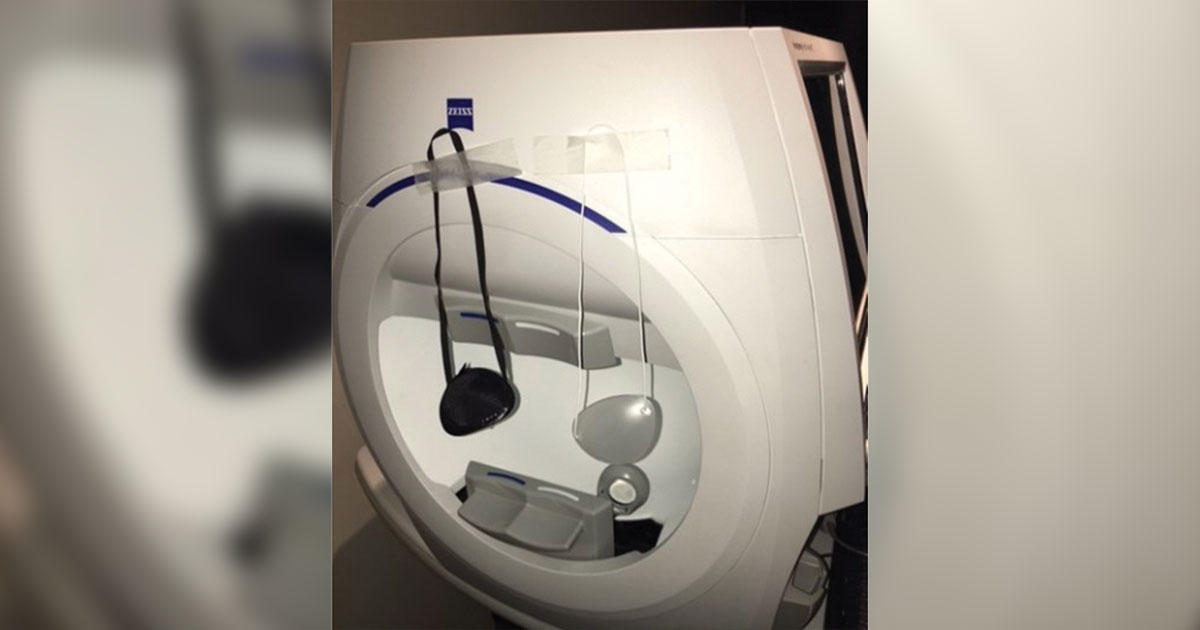Elimination of eye patch using diffusion improves visual field testing
We found that current opaque eye patches can cause 18 problems during visual field testing.
Most unusual was repetitive blackout of vision in the tested eye from the difference in illumination between the two eyes, called the Ganzfeld effect. When this blackout occurs, the patient has difficulty seeing the smaller targets, which causes spot retesting by the machine and prolongs the test. One can see this fading of vision by staring at a brightly lit wall with both eyes open from a distance of 20 inches for 15 seconds. When you then cover one eye, you should notice that after about 8 seconds, the vision in the other eye blacks out repeatedly.

All 18 of the problems were corrected by putting a diffusion, not occlusion, “patch” onto the machine, not on the patient’s head.
Two changes to current visual field testing
The first change is to eliminate bowl blackout by presenting a similar amount of light to both eyes. We used diffusion (passes most of the light to the eye), not occlusion (passes no light to the eye).

Source: John Karickhoff, MD, and Gustavo Corrales, MD
We did a study and found that 15% of light difference between the two eyes is ideal.

The diffuser for this study was commercially manufactured to our specifications. It fits onto the small rack of the Haag-Streit Octopus 600 machine and also holds any auxiliary refractive lens during testing.
Our second change is to put the patch on the machine, not on the patient’s head.

Evaluating the two changes
1. A 60 visual field study was performed on 15 patients using both the supplied opaque eye patch and our diffuser on the Haag-Streit Octopus 600 machine (four field tests per patient.)

The results were that the opaque patch caused an average increase duration of visual field tests of 16 seconds in the right eyes and an average increased duration of 22 seconds in the left eyes.
In the study, a few patients tired some. To minimize this on the results, we rotated using the patch or the diffuser being used last.
We also informally did visual fields on the Zeiss Humphrey Field Analyzer 3 machine and found that its opaque patch caused blackout, but the diffuser patch did not cause blackout.

2. A questionnaire of the visual field patients consisted of eight questions that they answered “with the patch,” “with no patch” or “the same.”

The results were that having no eye patch gave the patients less anxiety, less uncertainty, less fading of the targets and less concern for cleanliness. The eye patch was distracting, and the patients preferred using no eye patch.
The cumulative comments from the four certified ophthalmic technicians who administered the visual field tests follow.
Improving visual fields
1. If you own the Haag-Streit Octopus 600, you can purchase the Corrales/Karickhoff visual field fatigue diffuser converter (Good-Lite). This add-on diffuser converts this machine so it provides all 18 of our improvements.
2. On machines other than the Haag-Streit Octopus 600, a partial solution is to purchase the Karickhoff visual field fatigue diffuser eye patch (Good-Lite). This diffuser converts those machines to provide six improvements (13 to 18 below).
3. One could purchase a virtual reality visual field machine. The machine we purchased provided all 18 of our visual field improvements without modification.
Conclusions
Two inexpensive changes (using no eye patch and using diffusion to block vision) resulted in 18 improvements to traditional visual field testing.
Improvements from eliminating the eye patch include:
1. the patient is not distracted by an eye patch;
2. the technician does not need to place an eye patch on the patient;
3. a patch is not moved from one eye to the other;
4. a patch is not removed from the patient’s head;
5. no need to monitor the patch position because there is no patch;
6. no need to monitor the diffuser position because it cannot move;
7. no need to hunt for the diffuser because it is always stored with the auxiliary lenses in the machine;
8. no cleaning of the patch because there is no patch;
9. no cleaning of the diffuser because it does not touch the patient;
10. cheating eliminated because the patient cannot see around the diffuser on the machine;
11. more visual fields are done because some patients who cannot tolerate visual fields with an eye patch tolerated the no-patch method; and
12. patients preferred using no eye patch.
Improvements from using diffusion, not occlusion, to block vision in one eye during the test include:
13. visual fields are shorter in duration because there is no repeat target testing from bowl blackout;
14. visual fields are more accurate because there are no mistakes from blackout;
15. the patient has less anxiety and is more relaxed;
16. patients has less uncertainty with the diffuser;
17. patients has less fading of targets; and
18. patients prefer the diffuser.
- Reference:
- Fuhr PS, et al. Arch Ophthalmol. 1990;doi:10. 1001/archopht.1990.01070090085045.
- For more information:
- Gustavo Corrales, MD, of Emerson Clinical Research Institute, Washington, D.C., can be reached at guscor@gmail.com.
- John Karickhoff, MD, of Corrales Ocular Innovation Institute, Falls Church, Virginia, can be reached at jrk538@gmail.com.
